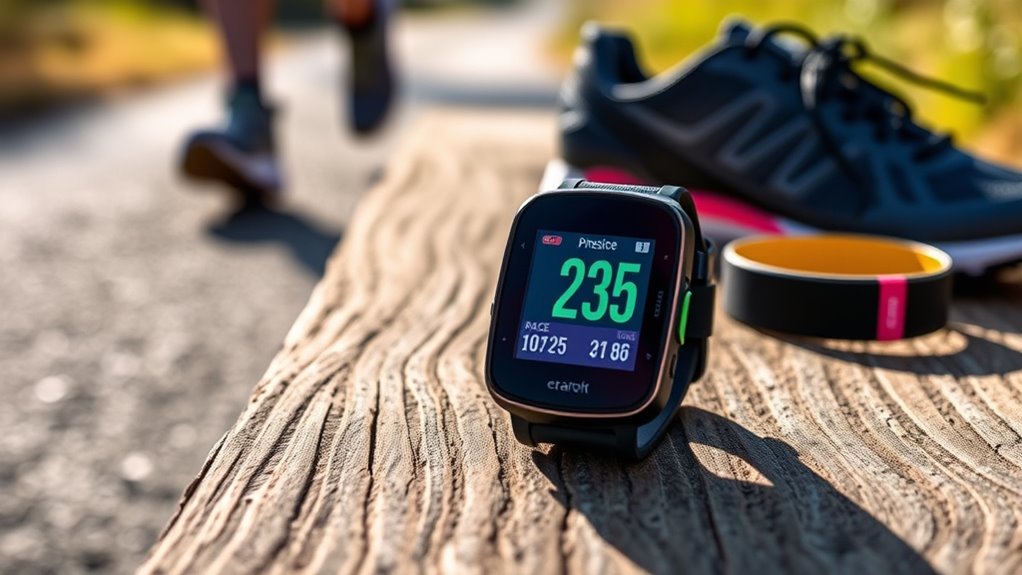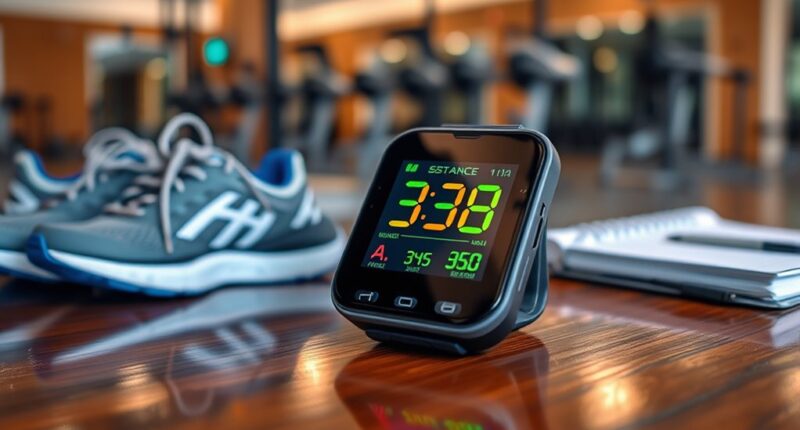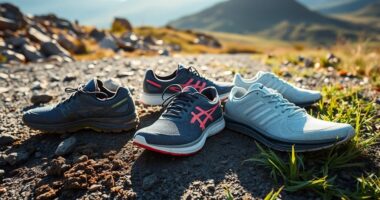If you want to monitor your running progress like a pro, I recommend checking out top trackers like the Suunto Race 2, Garmin Forerunner series, and smartwatches with AMOLED displays. These devices offer accurate GPS, health metrics, and customizable features that keep you motivated. Durability and battery life matter, too. Stay with me, and you’ll discover even more options to enhance your running experience and reach your goals efficiently.
Key Takeaways
- Choose devices with accurate GPS and outdoor tracking features for precise distance and route measurement.
- Prioritize models with comprehensive health metrics like heart rate, HRV, and oxygen levels to monitor recovery and fitness.
- Opt for smartwatches with customizable sport modes and real-time stats to tailor your training and track progress effectively.
- Ensure long battery life to support extended runs and outdoor activities without frequent recharging interruptions.
- Consider durability, water resistance, and compatibility with external sensors for reliable, versatile, and seamless tracking.
SUUNTO Race 2 GPS Sports Watch
If you’re serious about tracking your runs and pushing your limits, the Suunto Race 2 GPS Sports Watch is a top choice. Its sleek, lightweight design makes it comfortable for all-day wear, and the 1.5-inch AMOLED touchscreen with a crown ensures easy navigation. With over 115 sport modes, it’s versatile enough for trail running, cycling, swimming, and more. The dual-band GPS and ClimbGuidance provide precise outdoor tracking, while up to 16 days of battery life means fewer charges. Plus, it offers personalized training insights, recovery tools, and future updates via the Suunto App, making it a reliable, all-in-one device for athletes and enthusiasts alike.
Best For: athletes and fitness enthusiasts seeking a versatile, durable GPS sports watch with advanced training and outdoor tracking features.
Pros:
- Lightweight, sleek design for comfortable all-day wear
- Over 115 sport modes for a wide range of activities
- Long battery life of up to 16 days in daily use and 55 hours in GPS mode
Cons:
- AMOLED touchscreen may drain the battery faster during extended use
- Premium features might come at a higher price point
- Limited details about water resistance specifications in the provided info
Garmin Forerunner 165 Running Smartwatch
Looking for a lightweight and user-friendly running smartwatch that delivers accurate tracking without unnecessary bells and whistles? The Garmin Forerunner 165 fits the bill perfectly. It’s just 43 mm, with a colorful AMOLED touchscreen that stays clear in bright sunlight. Its minimalistic design is durable, with customizable straps and watch faces. It offers precise GPS, wrist-based heart rate, and over 25 activity profiles, including running and cycling. The battery lasts up to 11 days in smartwatch mode and 19 hours with GPS. Overall, it’s an intuitive, reliable device that helps you improve your training and stay motivated without overcomplicating things.
Best For: runners and fitness enthusiasts seeking a lightweight, straightforward smartwatch with accurate tracking and customizable features.
Pros:
- Accurate GPS and wrist-based heart rate monitoring
- Bright, colorful AMOLED touchscreen display visible in sunlight
- Long battery life of up to 11 days in smartwatch mode
Cons:
- Lacks advanced smartwatch features like payments and messaging replies
- Occasional Bluetooth disconnections may occur
- Limited health condition input options and some recovery time inaccuracies
Garmin Forerunner 55 GPS Running Watch
The Garmin Forerunner 55 GPS Running Watch stands out as an excellent choice for beginner to intermediate runners seeking an affordable yet reliable tracking device. It offers accurate GPS for pace, distance, and routes, along with wrist-based heart rate monitoring. The watch supports various activities like running, cycling, swimming, and HIIT, plus personalized workouts and PacePro guidance. Its wellness features include stress tracking, Body Battery, and fitness age. With up to two weeks of battery life, a lightweight design, and a user-friendly interface, it’s perfect for daily wear. Many users find it motivates them and delivers solid performance without breaking the bank.
Best For: beginner to intermediate runners seeking an affordable, reliable GPS watch with comprehensive wellness and activity tracking.
Pros:
- Accurate GPS and wrist-based heart rate monitoring for reliable tracking
- Long battery life of up to 2 weeks in smartwatch mode, ideal for extended use
- Lightweight and comfortable design suitable for all-day wear
Cons:
- Lacks music storage and contactless payment features
- Display resolution, while clear, is not as high as premium models
- No advanced training metrics or medical-grade health monitoring
Smart Watch GPS with AMOLED Display and Health Features
A smartwatch with an AMOLED display and advanced health features is essential for serious runners who want real-time insights and seamless connectivity. Its vivid 2.06-inch always-on touchscreen makes viewing stats easy, even outdoors. Bluetooth 5.4 lets me make calls and get social media notifications right on my wrist, while the built-in voice assistant simplifies music control and quick questions. With independent GPS supporting multiple satellite systems, I get accurate route, pace, and distance tracking, plus environmental sensors for altitude and air pressure. Monitoring over 100 sports modes, SpO2, heart rate, and sleep quality, it keeps my health in check. Plus, its 7-10 day battery life and water resistance make it a reliable running companion.
Best For: fitness enthusiasts and runners seeking a durable, feature-rich smartwatch with accurate GPS, health monitoring, and seamless connectivity.
Pros:
- Vivid 2.06-inch AMOLED Always-On display for easy outdoor viewing
- Independent multi-satellite GPS for precise route and activity tracking
- Extensive health features including SpO2, heart rate, sleep monitoring, and 100+ sports modes
Cons:
- Not suitable for swimming due to 5 ATM water resistance
- Battery life may decrease with continuous GPS usage (about 3 days)
- Limited customization options beyond watch faces and video uploads
Smart Fitness Bracelet with Heart Rate and Sleep Tracking
If you’re serious about monitoring your health and optimizing your workouts, this smart fitness bracelet stands out with its continuous heart rate and sleep tracking features. It offers over 170 sports modes, from yoga to city running, with automatic GPS route syncing for outdoor activities. The device tracks heart rate, SpO2, blood pressure, and stress 24/7, providing daily health reports and abnormal heart rate alerts. Its feather-light design, made from skin-friendly materials, feels invisible on your wrist. With up to 30 days of battery life and waterproof durability, it’s perfect for active lifestyles. Plus, customizable notifications and AI-powered wellness features keep you informed and motivated.
Best For: Fitness enthusiasts and health-conscious individuals seeking a lightweight, comprehensive wearable with advanced health tracking and long battery life.
Pros:
- Over 170 sports modes with automatic GPS route syncing for outdoor activities
- Continuous 24/7 monitoring of heart rate, SpO2, blood pressure, and stress levels
- Ultra-lightweight design (25g) with durable, waterproof, and skin-friendly materials
Cons:
- Does not support hot water immersion, limiting use during hot showers or baths
- Requires Bluetooth connection for certain features, which may drain phone battery faster
- Limited color options for interchangeable bands, depending on availability
Garmin vívoactive 5 GPS Smartwatch
For runners who want a versatile smartwatch that combines advanced GPS tracking with all-encompassing health monitoring, Garmin vívoactive 5 stands out as an excellent choice. Its bright AMOLED display makes it easy to read in any light, while the sleek, lightweight design ensures comfort during long runs. With up to 11 days of battery life, it supports extended workouts and daily monitoring. The watch tracks heart rate, stress, sleep, and even menstrual cycles, providing personalized insights. Plus, it offers over 30 sports modes, music storage, contactless payments, and smart notifications, making it a thorough tool to monitor your progress like a pro.
Best For: runners and fitness enthusiasts seeking a versatile GPS smartwatch with comprehensive health tracking and long battery life.
Pros:
- Bright AMOLED display for easy readability in all lighting conditions
- Up to 11 days of battery life supports extended use and workouts
- Extensive health monitoring features including heart rate, stress, sleep, and menstrual tracking
Cons:
- Slightly higher price point compared to basic fitness trackers
- Limited storage capacity of 4 GB may restrict music storage for some users
- The device’s advanced features may require a learning curve for new users
Smart Fitness Bracelet with Heart Rate, Blood Pressure, HRV, Stress Monitoring, Sleep Tracker, 170+ Sports Modes, Includes 2 Bands and App
This smart fitness bracelet stands out for its thorough health monitoring features, making it ideal for anyone serious about tracking their well-being and athletic performance. It offers 24/7 heart rate, blood pressure, oxygen, HRV, and stress monitoring with advanced sensors and AI. With over 170 sports modes, including running, yoga, and cycling, plus GPS routes, it helps optimize workouts. Sleep tracking covers all stages, ensuring better rest. Bluetooth notifications keep you connected discreetly. Its lightweight, stylish design with dual straps ensures all-day comfort, and the water resistance supports active lifestyles. The app provides detailed insights, goal setting, and lifetime updates, making it a holistic health companion.
Best For: fitness enthusiasts and health-conscious individuals seeking comprehensive, real-time activity and health monitoring with a stylish, comfortable design.
Pros:
- Extensive health tracking capabilities including heart rate, blood pressure, HRV, stress, and sleep stages.
- Over 170 sports modes with GPS options for detailed workout analysis and route mapping.
- Long battery life of up to 30 days and durable, water-resistant design suitable for daily active use.
Cons:
- Screenless design may not appeal to users who prefer visual display and instant data at a glance.
- Not suitable for swimming or diving despite water resistance, limiting some water-based activities.
- Requires Bluetooth connection to the app for full functionality, which may impact connectivity in certain environments.
Apple Watch Series 10 GPS 46mm Smartwatch with Jet Black Aluminium Case
The Apple Watch Series 10 GPS 46mm with its larger, always-on Retina display makes it an excellent choice for runners who want clear, real-time metrics on the go. Its bigger screen provides up to 30% more space, making stats easier to read during workouts. The sleek, lighter design with a durable Jet Black Aluminum Case ensures comfort and resilience, even in tough conditions, thanks to its crack resistance, dustproof, and water-resistant features. It offers advanced health insights like ECG and Blood Oxygen monitoring, along with sleep and activity tracking. Plus, safety features like Fall Detection and Emergency SOS give peace of mind, all while seamlessly connecting to your iPhone.
Best For: runners and fitness enthusiasts seeking a durable, feature-rich smartwatch with a larger display for real-time health metrics and seamless connectivity.
Pros:
- Larger, always-on Retina display with up to 30% more screen area for easy readability during workouts
- Durable design with crack resistance, dustproof, and water resistance up to 50m, suitable for various environments
- Advanced health tracking features including ECG, Blood Oxygen, sleep monitoring, and safety alerts like Fall Detection
Cons:
- Slightly heavier or bulkier design compared to smaller models, which may affect comfort for some users
- Higher price point typical of premium smartwatches with advanced features
- Limited battery life with faster charging needed for extended use throughout the day
Apple Watch SE (2nd Gen) GPS 40mm Smartwatch with Lake Green Sport Loop
If you’re looking for a versatile running meter tracker that combines fitness tracking with smart features, the Apple Watch SE (2nd Gen) GPS 40mm with Lake Green Sport Loop is an excellent choice. It offers essential tools like activity and sleep tracking, heart rate monitoring, Fall Detection, Crash Detection, and Emergency SOS for safety. Its seamless integration with iPhone and Apple services means you can send messages, make calls, or use Apple Pay effortlessly. The swimproof design with water resistance up to 50m, customizable bands, and vibrant Lake Green Sport Loop make it both functional and stylish. Plus, it supports a healthy lifestyle with workout options and free Apple Fitness+ trials.
Best For: those seeking a versatile, stylish smartwatch with comprehensive fitness and safety features that seamlessly integrates with the Apple ecosystem.
Pros:
- Combines fitness tracking, health monitoring, and safety features like Fall Detection and Emergency SOS in one device.
- Fully compatible with iPhone and Apple services, enabling effortless communication and device management.
- Durable, swimproof design with customizable bands and vibrant Lake Green Sport Loop for personalized style.
Cons:
- Limited to use within the Apple ecosystem, which may not suit Android users.
- Smaller 40mm size may not be ideal for users preferring larger watch faces.
- Requires an iPhone for full functionality, limiting standalone use.
Apple Watch Series 10 GPS 46mm Smartwatch with Black Aluminium Case and Sport Loop
For runners who want a smartwatch that combines advanced health tracking with seamless connectivity, the Apple Watch Series 10 GPS 46mm is an excellent choice. Its larger, always-on Retina display offers clear visuals, while the thinner, lighter design guarantees comfort during long runs. It’s built tough—crack-resistant, dustproof, and water-resistant up to 50 meters. Health features like ECG, blood oxygen monitoring, sleep tracking, and heart rate alerts keep you informed. Safety is a priority too, with fall detection and emergency SOS. Plus, it syncs effortlessly with your iPhone, supports music and notifications, and charges quickly, making it a versatile running companion.
Best For: runners seeking a durable, feature-rich smartwatch with advanced health monitoring and seamless iPhone connectivity.
Pros:
- Larger, always-on Retina display for easy visibility during workouts
- Comprehensive health features including ECG, blood oxygen, sleep, and heart rate tracking
- Robust and water-resistant design suitable for various outdoor activities
Cons:
- Higher price point compared to basic fitness trackers
- Limited compatibility outside the Apple ecosystem
- Shorter battery life with frequent use of advanced health and display features
Factors to Consider When Choosing a Running Meter Tracker

When choosing a running meter tracker, I look at how well it works with my devices and its battery life to guarantee it fits my routine. I also consider the health features it offers and how tough it is against water and wear. Finally, I check if it has the sport modes I need to track different activities accurately.
Compatibility With Devices
Choosing a running meter tracker that works seamlessly with your devices is essential for a smooth workout experience. I always check if the tracker is compatible with my smartphone’s operating system—whether iOS or Android—to guarantee effortless synchronization. It’s also important to verify if the device supports Bluetooth, Wi-Fi, or other wireless protocols needed to connect reliably. I look for compatibility with my existing fitness apps or platforms so I can integrate data smoothly without switching tools. If I use external sensors like heart rate monitors or foot pods, I confirm they’re compatible with the tracker. Finally, I review the connection requirements and limitations to make sure data transfer remains consistent during my runs. Seamless device compatibility keeps my workouts accurate and hassle-free.
Battery Performance Expectations
Battery performance is a crucial factor to contemplate because it directly affects how long your running tracker can last during workouts. Some devices can last over a week on a single charge, while others may need daily recharging, especially with intensive use. Features like GPS tracking and continuous heart rate monitoring considerably impact battery life, often reducing endurance during active sessions. Many trackers include power-saving modes or adjustable settings to extend battery life when full features aren’t necessary. Battery capacity, measured in mAh, also plays a role—higher capacity generally means longer use between charges. Ultimately, your real-world battery life depends on your usage habits; frequent GPS use and advanced sensors tend to drain power faster compared to basic activity tracking.
Key Health Monitoring Features
To get the most out of your running tracker, it’s essential to focus on key health monitoring features that provide valuable insights into your fitness and recovery. Accurate wrist-based heart rate monitoring helps you understand exercise intensity and cardiovascular health. Continuous SpO2 measurement offers insights into oxygen saturation, indicating respiratory efficiency and recovery status. Sleep tracking that monitors sleep stages and quality supports better recovery and overall fitness management. Heart rate variability (HRV) analysis reveals stress levels and recovery, allowing for smarter training adjustments. Additional sensors for blood pressure and blood oxygen levels can detect potential health issues and optimize your training plan. Prioritizing these features ensures your tracker offers *thorough* health insights, helping you train smarter and recover faster.
Durability and Water Resistance
Durability and water resistance are essential factors when selecting a running meter tracker, especially since it will face outdoor elements and daily wear. A good tracker should have a water resistance rating of at least 5 ATM, so it can handle sweat, rain, and splashes without issue. Durable materials like reinforced silicone, stainless steel, or aluminum casings protect against drops, bumps, and scratches. Look for devices with reinforced screens or Gorilla Glass to prevent damage from impacts. Higher water resistance ratings, such as IP68, mean the device can be submerged in water and used for swimming or prolonged water exposure. Additionally, check the overall build quality and certifications to guarantee the tracker can withstand rugged outdoor conditions over time, giving you peace of mind during intense workouts.
Sport Mode Selection
Choosing the right sport modes on your running meter tracker is essential for getting accurate and meaningful data. I look for devices that offer over 100 sport modes, ensuring I can track various running activities and training types precisely. It’s important that the modes include metrics like pace, cadence, stride length, and heart rate zones, so I get relevant insights into my performance. I prefer trackers with customizable sport modes, allowing me to tailor the data to my specific running style or terrain. Seamless switching between modes, whether automatic detection or manual selection, helps keep my focus on training without interruption. finally, detailed performance insights for each mode enable me to analyze progress and optimize my training effectively.
Display Clarity and Size
Ever wonder how easy it is to read your stats during a run? A larger display size can make monitoring your progress much simpler, especially when you need quick glances. High-resolution screens provide sharp, clear visuals that reduce eye strain and improve readability in various lighting conditions. If you run outdoors, an AMOLED display offers vibrant colors and deep blacks, enhancing contrast and visibility. An always-on display lets you view essential data continuously without waking the device, ensuring seamless tracking. Brightness levels and anti-glare coatings also play a crucial role, especially in direct sunlight, where glare can obscure your view. Choosing a tracker with a clear, appropriately sized screen means you stay focused on your run without constantly adjusting or squinting at your device.
Connectivity and App Support
Connecting your running meter tracker to your smartphone is essential for seamless data sharing and accurate tracking. Make sure the device is compatible with your phone’s operating system—whether iOS or Android—to guarantee smooth app integration. Look for trackers that support Bluetooth and Wi-Fi; these enable real-time synchronization and effortless data transfer to your app. A good tracker should come with a dedicated or compatible app offering detailed analytics, training plans, and social sharing features to keep you motivated. Verify that it supports automatic data syncing, GPS route tracking, and updates for health metrics via the app, ensuring your data stays current. Firmware update capabilities are also important, so you can access new features and security improvements over time.
Frequently Asked Questions
How Do Running Trackers Improve Long-Term Workout Consistency?
Running trackers keep me motivated and accountable, which boosts my long-term consistency. They provide real-time feedback on my progress, helping me set achievable goals and see my improvements over time. Knowing I can track my pace, distance, and calories burned makes me more committed to sticking with my routine. Plus, they turn workouts into a game, making me want to push myself further and stay consistent.
Can Running Meters Accurately Measure Indoor Treadmill Runs?
Yes, running meters can accurately measure indoor treadmill runs, especially if they’re equipped with reliable sensors. I find that most modern trackers sync well with treadmill data, providing precise distance measurements. However, I always double-check calibration and verify the device is compatible with my treadmill for the best accuracy. This way, I can confidently monitor my progress and stay motivated, even indoors.
What Features Help Prevent Injuries During Training?
To prevent injuries during training, I focus on features like real-time heart rate monitoring, which helps me stay within safe zones. I also look for devices with GPS tracking to analyze my terrain and pacing, plus built-in accelerometers to detect improper stride or overexertion. Additionally, adjustable alerts remind me to rest or slow down when needed. These features keep me aware and help me train smarter and safer.
How Do Trackers Accommodate Different Running Terrains?
Trackers adapt to different terrains like a chameleon changing colors. I’ve found they use GPS technology to map your route precisely, adjusting for elevation and surface type. Some models even have built-in sensors to detect ground impact and terrain changes, providing tailored feedback. This way, I stay aware of how surfaces affect my run, helping me adjust my pace and prevent injuries, no matter if I’m on pavement, trail, or track.
Are Running Meters Compatible With Third-Party Fitness Apps?
Yes, running meters are compatible with third-party fitness apps. I’ve found that many trackers sync seamlessly through Bluetooth or ANT+ connections, allowing me to upload my data effortlessly. This compatibility helps me analyze my runs in detail, compare progress over time, and integrate with apps like Strava or MyFitnessPal. Just make sure your device supports the specific app you want to use, and you’re good to go!
Conclusion
Choosing the right running meter tracker is like planting a seed—when you pick the right one, it grows with you, revealing new strengths and guiding your journey. Whether you prefer the precision of GPS watches or the versatility of smart bracelets, each option helps you map your progress and push forward. Remember, the best tracker isn’t just a device; it’s your steady companion on the path to becoming your best self.










![Apple Watch Series 10 [GPS 46mm case] Smartwatch with Jet](https://m.media-amazon.com/images/I/41d54eAvMRL._SL500_.jpg)
![Apple Watch SE (2nd Gen) [GPS 40mm] Smartwatch with Starlight](https://m.media-amazon.com/images/I/41mcaZxUj9L._SL500_.jpg)






